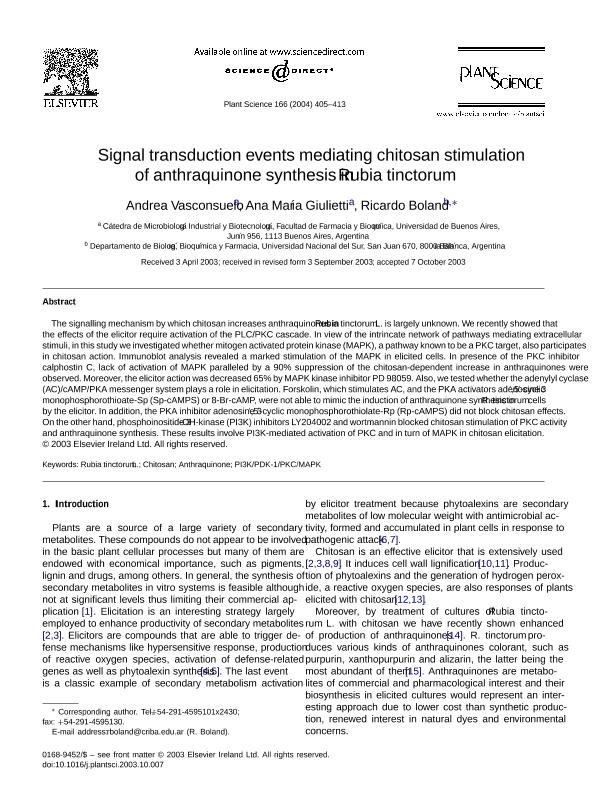Mostrar el registro sencillo del ítem
dc.contributor.author
Vasconsuelo, Andrea Anahi

dc.contributor.author
Giulietti, Ana Maria

dc.contributor.author
Boland, Ricardo Leopoldo

dc.date.available
2020-02-17T20:31:19Z
dc.date.issued
2004-12
dc.identifier.citation
Vasconsuelo, Andrea Anahi; Giulietti, Ana Maria; Boland, Ricardo Leopoldo; Signal transduction events mediating chitosan stimulation of anthraquinone synthesis in Rubia tinctorum; Elsevier Ireland; Plant Science; 166; 2; 12-2004; 405-413
dc.identifier.issn
0168-9452
dc.identifier.uri
http://hdl.handle.net/11336/97824
dc.description.abstract
The signalling mechanism by which chitosan increases anthraquinones in Rubia tinctorum L. is largely unknown. We recently showed that the effects of the elicitor require activation of the PLC/PKC cascade. In view of the intrincate network of pathways mediating extracellular stimuli, in this study we investigated whether mitogen activated protein kinase (MAPK), a pathway known to be a PKC target, also participates in chitosan action. Immunoblot analysis revealed a marked stimulation of the MAPK in elicited cells. In presence of the PKC inhibitor calphostin C, lack of activation of MAPK paralleled by a 90% suppression of the chitosan-dependent increase in anthraquinones were observed. Moreover, the elicitor action was decreased 65% by MAPK kinase inhibitor PD 98059. Also, we tested whether the adenylyl cyclase (AC)/cAMP/PKA messenger system plays a role in elicitation. Forskolin, which stimulates AC, and the PKA activators adenosine 3′,5′-cyclic monophosphorothioate-Sp (Sp-cAMPS) or 8-Br-cAMP, were not able to mimic the induction of anthraquinone synthesis in R. tinctorum cells by the elicitor. In addition, the PKA inhibitor adenosine 3′,5′-cyclic monophosphorothiolate-Rp (Rp-cAMPS) did not block chitosan effects. On the other hand, phosphoinositide 3′-OH-kinase (PI3K) inhibitors LY204002 and wortmannin blocked chitosan stimulation of PKC activity and anthraquinone synthesis. These results involve PI3K-mediated activation of PKC and in turn of MAPK in chitosan elicitation.
dc.format
application/pdf
dc.language.iso
eng
dc.publisher
Elsevier Ireland

dc.rights
info:eu-repo/semantics/openAccess
dc.rights.uri
https://creativecommons.org/licenses/by-nc-sa/2.5/ar/
dc.subject
ANTHRAQUINONE
dc.subject
CHITOSAN
dc.subject
PI3K/PDK-1/PKC/MAPK
dc.subject
RUBIA TINCTORUM L.
dc.subject.classification
Otros Tópicos Biológicos

dc.subject.classification
Ciencias Biológicas

dc.subject.classification
CIENCIAS NATURALES Y EXACTAS

dc.title
Signal transduction events mediating chitosan stimulation of anthraquinone synthesis in Rubia tinctorum
dc.type
info:eu-repo/semantics/article
dc.type
info:ar-repo/semantics/artículo
dc.type
info:eu-repo/semantics/publishedVersion
dc.date.updated
2020-02-13T14:07:51Z
dc.journal.volume
166
dc.journal.number
2
dc.journal.pagination
405-413
dc.journal.pais
Irlanda

dc.journal.ciudad
Shannon
dc.description.fil
Fil: Vasconsuelo, Andrea Anahi. Universidad de Buenos Aires. Facultad de Farmacia y Bioquímica. Departamento de Microbiología, Inmunología y Biotecnología. Cátedra de Microbiología Industrial y Biotecnología; Argentina. Consejo Nacional de Investigaciones Científicas y Técnicas. Oficina de Coordinación Administrativa Houssay; Argentina
dc.description.fil
Fil: Giulietti, Ana Maria. Consejo Nacional de Investigaciones Científicas y Técnicas. Oficina de Coordinación Administrativa Houssay; Argentina. Universidad de Buenos Aires. Facultad de Farmacia y Bioquímica. Departamento de Microbiología, Inmunología y Biotecnología. Cátedra de Microbiología Industrial y Biotecnología; Argentina
dc.description.fil
Fil: Boland, Ricardo Leopoldo. Consejo Nacional de Investigaciones Científicas y Técnicas. Centro Científico Tecnológico Conicet - Bahía Blanca; Argentina. Universidad Nacional del Sur. Departamento de Biología, Bioquímica y Farmacia; Argentina
dc.journal.title
Plant Science

dc.relation.alternativeid
info:eu-repo/semantics/altIdentifier/doi/https://doi.org/10.1016/j.plantsci.2003.10.007
dc.relation.alternativeid
info:eu-repo/semantics/altIdentifier/url/https://www.sciencedirect.com/science/article/pii/S0168945203004485
Archivos asociados
